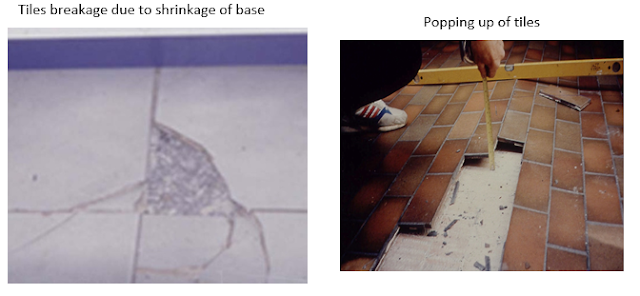Nothing
is static. It is known to everyone that everything in this world moves at its
own speed or due to its properties and it is especially true in buildings.
Concrete and mortar expand and contracts so do with wood and other building
materials also. Hence, the basic answer is the movement and it is very
important to accommodate this movement or else this movement will cause the
failure of the materials installed. Here are some of the failures caused by the
movement:-
In the
above photos, it is observable that the tiles/stones are installed without joint
gaps and the installed tiles/ stones are unable to accommodate the movements,
as a result, debonding and popping up occurs.
What makes the tiles/stones to move?
The tiles
/ stones fixed on the wall/floor will also make movement due to many reasons.
The following are a few reasons which make the installed tiles/stones to move:-
Physical Building Movement: This is the movement of vibration and deflection
caused by the process of installation of other building application /
materials. This type of movement is the most common and will lead to failure if
the proper measures are not implemented.
Shrinkage of Concrete / Mortar: Shrinkage of concrete/mortar occurs during the
process of curing and hydration. In today’s world, fast track construction
has become normal to install tiles/stones over new concrete/mortar surfaces
that may not undergo all the shrinkage that it shall. In many cases, you may
see tiles / stones tented up over new installations. The continuous shrinkage
of concrete takes place; as a result the gap is formed in between tiles /
stones and concrete / mortar.
Thermal Movement: The thermal movement includes temperature fluctuations
and changes in the environment. It is easy to understand in case of exterior
applications. All installed tiles / stones are subjected to the continuous
cycle of cooling and heating systems, that heat and cool the air. Moving air
across the installation will cause the temperature to fluctuate and results in
movement.
In
exteriors, imagine an installation exposed to the sun, these installations can
reach surface temperatures up to 140°F (60°C). If a quick rain shower comes and
douses the installation with cool rain. In this instance, the surface
temperature will drop to 70°F (21°C) within a few seconds. This type of stress
needs to be accommodated by joints between the tiles / stones or else,
debonding occurs. Interior installations that have skylights or area surrounded
by windows and glass doors needs to be treated as exterior applications.
Moisture: In
some cases, the finish material used shall absorb moisture due to its porosity.
Over time, this absorption of moisture shall cause growth in the finish
material. This growth can lead to loss of bond, if place is not available to
accommodate movement.
Dissimilar Building Materials: The use of dissimilar materials
in the construction is unavoidable and this leads to dissimilar joints. There
will be always movement in between the two different building materials, if they
are not treated well, this movement will transfer to the surface where tiles/
and stones are present.
Is the
paper joint is not enough?
If we
install the tiles / stones side by side, allowed to cure and dry for 24 hrs.
After that, it needs the sealing of joints. For any material, used to grout the
joint gap, shall need some surface to adhere strongly, so that it avoids the
penetration of water, acid and other contaminants to the substrate on which the
tiles / stones are installed. But, in case of paper joints the surface of
adhesion is very small and the provided grout material will goes off making the
place for the contaminants. These contaminants will spread around the edges of
the tiles creating unhygienic surface all over the installation.In all
the above mentioned cases, it is best honour to provide joint gaps between the
tiles/ stones, so that it can accommodate the movements. What if, we provide
the paper joint i.e. installing the tiles/ stones just side by
side?
Whatever
the material which has been used as grout for provided paper joint, will
definitely fails within a short period and causes the effect as shown in the
photos. The weak paper joints will show the way to dirt, moisture, chemicals
and other contaminants to get inside the substrate from the top and may causes
weakness in the substrate.
In order
to avoid the failure of substrate and also to increase the durability of the
tiles / stones, it is strongly recommended to provide the minimum joint of 2 mm
between the tiles / stones and grouted with proper recommended grouts.
Other
uses of tile joint grouting:
Tile and
stone joints will avoid the cracks extension and avoid the damages to the
adjacent tile & stone.
Hides the the imperfection of tile & stone edges.
Improves
the look, beauty/handsomeness, and appearance…
Accommodates
the movement.
Provides the easy cleanable surface, hence no chance of place to mould growth.
Many thanks to google.com, doc4242, dindoc, from where the details have been collected.








Awesome and excellent post, thanks for this kind of blog that may help a lot for those who wants Sealant & Adhesive Manufacturer In UAE. pls check below our Products.
ReplyDeleteAcrylic Sealant
Alkoxy Silicone Sealant
Construction Silicone Sealant
Fire Stop Acrylic Sealant
Hybrid Sealant
Structural Glazing Silicone Sealants
Silicone Sealants Manufacturers
Hybrid Construction Sealants
Silicone Construction Sealants
Specialty Silicone Sealants
Structural Glazing Sealant
Industrial Adhesives Products In UAE
Contact Adhesive Manufacturer In Dubai
Adhesive Manufacturers In UAE
Adhesive In UAE
Construction Adhesives
Industrial Spray Paints
Cement Based Waterproofing Coating
Industrial Adhesive Tapes
Industrial Adhesive Manufacturers
Cyanoacrylate Adhesive Manufacturers
Contact Adhesive
Construction Adhesive Tapes
Cpvc Suppliers In UAE
Cyanoacrylate Adhesive
Maintaining tile & stone joints grout is crucial for preserving structural integrity, preventing moisture damage, and enhancing aesthetic appeal. Neglect leads to costly repairs.Atlanta Tile Installer
ReplyDelete